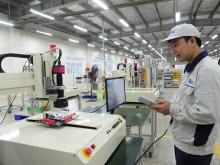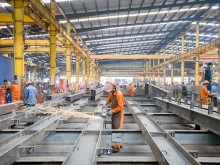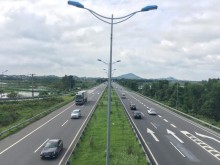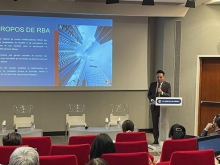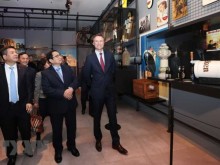Vietnam and the Netherlands are celebrating the 50th anniversary of the establishment of diplomatic relations (April 9, 1973-2023). The Saigon Times Weekly publishes an article by Tran Huu Phuc Tien to give its readers an insight into the relationship between the two countries.
Beginning of bilateral trade in 1633
The Netherlands was established in 1581, beginning the golden age of the northern European coastal country. With long trading and maritime experiences, the Netherlands boosted trade worldwide. In 1650, the Dutch owned 16,000 of the 20,000 vessels engaged in European trade and sailing to different continents. From many small companies, the Netherlands established two giant firms – Dutch East India Company and Dutch West India Company – to conduct large and professional intercontinental trade. Compared with other Western countries, the Netherlands pioneered to develop trade in North America, South Africa, Indonesia and Japan.
At the time, Dai Viet was in a civil war, initially the Le-Mac war (1545-1592) and then the Trinh-Nguyen war (1627-1775). The country was partitioned into Dang Ngoai whose capital was Thang Long (present-day Hanoi) and Dang Trong whose capital was Phu Xuan (present-day Thua Thien Hue).
In 1601 in Dang Trong, two Dutch merchant vessels came to Hoi An for the first time. With an intention to cooperate in trade, the authority of Nguyen lords later wrote to the Dutch East India Company in Batavia (now Indonesia’s Jakarta), which was the center of the Dutch East India Company’s trading network in Asia. However, it was not until 1633 that the two sides officially started trade cooperation and formed a Dutch trading agent in Hoi An. Four years later, the Netherlands began trading with Dang Ngoai and developed trading agents in Pho Hien (Hung Yen) and Thang Long. Therefore, if the year 1633 was seen as the starting point of Vietnam-Netherlands ties, the bilateral relationship would have existed for 390 years.
Promotion of two-way trade
The Dutch mainly bought silk, musk, valuable wood, tea, pottery and black sugar, among others, from Vietnam. Meanwhile, the Trinh and Nguyen lords primarily purchased guns, sulphur, saltpeter, munitions and weapons from the Netherlands. Moreover, Dang Trong and Dang Ngoai bought silver and coins from the Netherlands for domestic use and trade.
The Netherlands also sold fabric and high-end handmade items to both sides of Vietnam. The Netherlands used its trade organizations in Japan, Taiwan and Indonesia to transact with Dang Trong and Dang Ngoai. From 1641 to 1654, sales of silk to Dang Ngoai contributed 71% of the total profit of Dutch trading agents in Japan.
In Le Quy Don’s Phu bien tap luc, a handicraftsman named Nguyen Van Tu in Quang Tri followed a trading vessel to the Netherlands for two years to learn techniques to produce watches and binoculars.
As for relations with Dang Trong and Dang Ngoai, the Netherlands had different policies depending on its benefits and the policies of the authorities of Dang Trong and Dang Ngoai. The Dutch supported Dang Ngoai and even got involved in military attacks against Dang Trong.
Dang Ngoai and the Netherlands had close economic and military ties. In 1639 and 1642, the Trinh lords dispatched emissaries to Batavia. They also allowed the Netherlands to buy goods in Pho Hien and Thang Long. In 1642-1643, the Netherlands provided military support to Dang Ngoai by sending 13 warships and some 1,000 soldiers to fight against Dang Trong but faced heavy losses.
In 1651, to enhance bilateral relations, the Trinh lords adopted the Dutch governor-general in Indonesia. It was reported that King Le Than Tong (1607-1662) had a Dutch wife, who was the daughter of the deputy governor-general of the Netherlands in Taiwan.
The Netherlands’ support of Dang Ngoai led to the stagnation of trade between the Netherlands and Dang Trong. In 1639, the Dutch trading agent in Hoi An shut. It was not until 1651 that the Nguyen lords and the Dutch East India Company signed an agreement resuming their trade ties.
However, the two sides later mistrusted each other, so they failed to reconnect, and the Netherlands cooperated with only Dang Ngoai. The Netherlands later reopened its trading agent in Hoi An in 1752 but closed it in 1756.
Trade stagnation
From 1670, trade between the Netherlands and Dang Ngoai went downhill due to multiple reasons. Dang Ngoai suspended its attacks against Dang Trong, so its demand for military equipment imports plunged. In addition, due to depleted natural resources and wars, the supply of goods to Dang Ngoai was no longer abundant. Meanwhile, the cost to maintain the Dutch trading agents surged and the Netherlands had to compete more fiercely with traders from China and the United Kingdom.
As a result, in 1770, the Netherlands shut all its trading agents in Dang Ngoai after 64 years of continuous operation. In 1771, the Tay Son movement started in Quy Nhon and caused disturbance across Dang Trong. Taking advantage of the situation, the Trinh lords attacked Dang Trong in 1774, triggering a 28-year war.
Peace returned in 1802 after descendants of the Nguyen lords won the war and established the Nguyen Dynasty, which ruled a united Vietnam. However, the Nguyen Dynasty introduced the closed-door policy and was hesitant to set up relations with Western countries.
Trade between Vietnam and the Netherlands was limited before France invaded Vietnam.
Trade in late 19th and early 20th centuries
In 1858, France invaded Vietnam and turned Vietnam into its colony. The Dutch government and business community sought France’s permission to set up a consular office in Vietnam as part of their effort to maintain a presence in Asia. In 1867, the Dutch consular office was put into official operation in Saigon to promote trade. Thus, the relationship between the Netherlands and Saigon was established 155 years ago. In 1933, France allowed the Netherlands to open another consular office, which was located in Hanoi.
In 1870, the Dutch Government appointed Carl Theodorff Speidel, a German entrepreneur and owner of Speidel Company, as the Dutch consul in Saigon. Since then, the Netherlands’ trade activities in Vietnam were enhanced. The Netherlands sold Vietnamese rice to China and other markets. More Dutch trading vessels came to Vietnam and some Dutch people began residing and working in Vietnam.
At the beginning of the 20th century, the Netherlands exported large volumes of fuel to Vietnam. In 1902, Asiatic Petroleum, a joint venture between the United Kingdom and the Netherlands, whose headquarters was in Saigon (now the headquarters of Petrolimex at 15 Le Duan Boulevard, District 1, HCMC), regulated the import and sale of fuel in Indochina.
In 1904, Diethelm Company, a joint venture of Switzerland and the Netherlands, set up its office in Saigon (now the headquarters of Vietcombank at 29 Vo Van Kiet Avenue, District 1, HCMC). The company successfully traded in consumer goods, machines, autos, building materials, textiles and garments for decades.
Economic and political relations after WWII
After the Second World War (WWII), fights for national liberation broke out in many colonies, including Vietnam’s fight against France and Indonesia’s fight against the Netherlands. In 1949, the Netherlands recognized Indonesia’s independence.

After the Paris Peace Accords, the agreement on ending the war in Vietnam, was signed, the Netherlands established a partnership with the Democratic Republic of Vietnam. When Vietnam was reunited in 1975, the Netherlands opened its consular office in Hanoi in 1976 and its embassy in 1994. In HCMC, the Dutch Consulate General was established in 1997. Vietnam also set up its embassy in The Hague in 1998. Furthermore, the Netherlands’ air carrier KLM opened a direct air service between Amsterdam and HCMC.
The economic, political and cultural ties between Vietnam and the Netherlands have developed strongly. Besides trade and investment, Dutch universities have admitted a large number of Vietnamese students since 2000. Opportunities and potentials to develop bilateral ties remain huge thanks to their long-lasting relations and cooperation.
References:
1/ Lion and Dragon: Four Centuries of Dutch-Vietnamese Relations, many authors, The Gioi Publisher, 2008
2/ The West in Asia, Michael Edwardes, NXB Batsford, London, 1967
3/ Hoi An trading port city, many authors, Culture-Information Publisher, 2013








